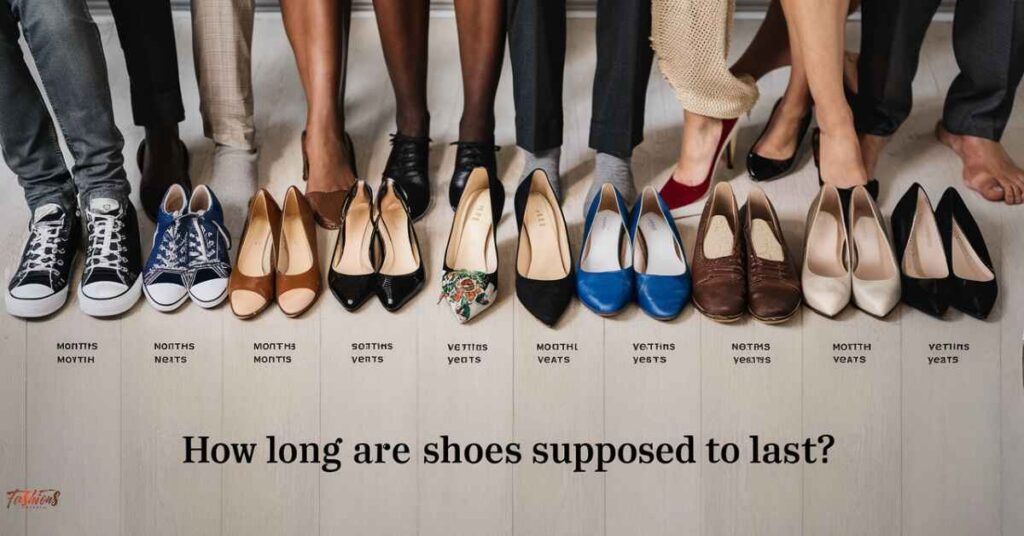Shoes, often overlooked yet integral to our daily lives, play a crucial role in providing comfort, support, and style. But have you ever wondered how long these essential accessories are meant to last?
Understanding the lifespan of different types of shoes is key to making informed decisions about their care and replacement. From leather dress shoes to athletic sneakers, each shoe type has its own durability factors influenced by usage, maintenance, and material quality. Let’s delve into the intriguing world of shoe longevity.
How Long Do Shoes Last as per Shoe Types?
Here is information about shoes based on their type.
How Long Do Leather Dress Shoes Last?
Leather dress shoes, known for their durability and timeless appeal, can last for several years with proper care. With regular polishing, occasional conditioning and resoling, when necessary, high-quality leather dress shoes can withstand daily wear and retain their elegance and functionality.
How Long Do Running/Walking Shoes Last?
Running and walking shoes are designed to provide support and cushioning for physical activities. On average, these shoes last between 350 to 500 miles, depending on factors such as the individual’s weight, running style, and the terrain they traverse. It’s recommended to monitor the shoe’s condition and replace them promptly to prevent discomfort and potential injuries.
How Long Do Hiking Shoes Last?
Hiking shoes are crafted to endure rugged terrains and varying weather conditions. Their lifespan ranges from 500 to 1,000 miles of hiking adventures, depending on the intensity and frequency of usage.
Regular cleaning, waterproofing and inspecting for wear and tear can prolong the longevity of hiking shoes and maintain their performance on outdoor trails.
How Long Do Sneakers Last?
Sneakers, popular for casual wear and light physical activities, typically last between 6 months to a year with regular use. The durability of sneakers depends on factors such as the quality of materials, frequency of wear and maintenance practices. Rotating between multiple pairs and keeping them clean can extend their lifespan and freshness.
How Long Do Work Shoes Last?
Work shoes encompass a wide range of styles tailored for various occupational needs, from heavy-duty boots to office-friendly footwear. The lifespan of work shoes varies significantly based on factors such as the type of work environment, the intensity of usage, and the quality of construction.
Heavy-duty work boots may last several years with proper care, while office shoes may require replacement every 1-2 years due to regular wear and tear.
How Long Do Casual Shoes Last?
Casual shoes, including loafers, flats, and sandals, offer comfort and style for everyday wear. Their lifespan typically ranges from 6 months to 2 years, depending on the materials used and how often they are worn. Proper storage, occasional cleaning and rotating between different pairs can help prolong the life of casual shoes and maintain their appearance and comfort.
Read this blog:
How Should Ballet Shoes Fit?
How Often Should You Replace Everyday Shoes?
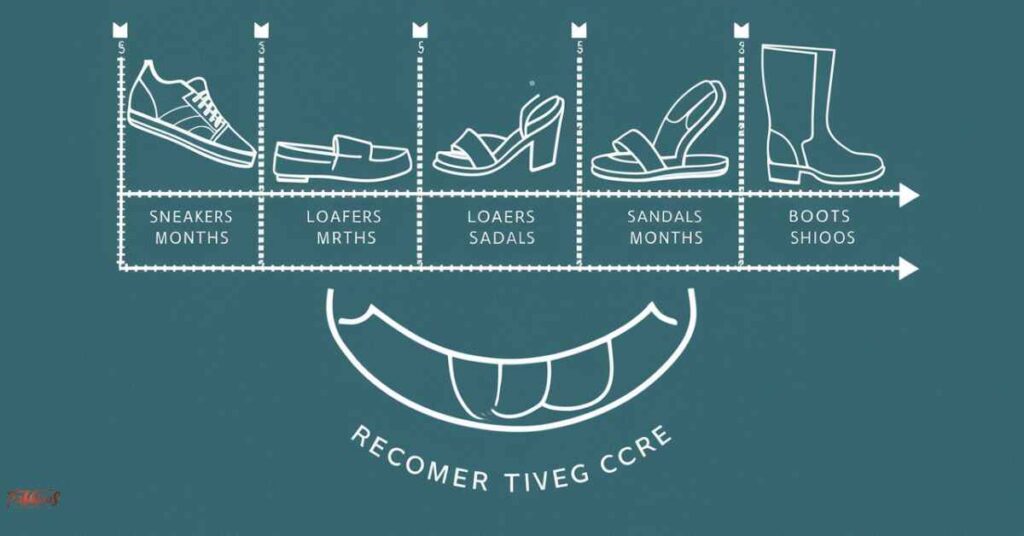
The frequency of replacing everyday shoes depends on several factors such as the type of shoe, usage patterns, and wear and tear. Generally, it’s recommended to assess your shoes periodically and consider replacement based on the following guidelines:
Mileage: For running or walking shoes, experts suggest replacing them every 350 to 500 miles. Keeping track of your mileage can help determine when it’s time for a new pair to maintain optimal support and cushioning.
Visible Wear and Tear: Inspect your shoes regularly for signs of wear such as worn-out outsoles, flattened midsoles, visible creases or tears in the upper material. These indicators suggest that the shoes may no longer provide adequate support and comfort.
Comfort and Fit: If you notice any discomfort, pain, or changes in how the shoes feel, it’s a sign that they may have worn out and need replacement. Shoes that no longer fit properly can also lead to foot issues and discomfort.
Activity Level: Consider your activity level and the intensity of use. Shoes used for high-impact activities or frequent outdoor adventures may wear out faster than those used for light daily activities.
Age of the Shoes: Even if your shoes appear to be in good condition, age can affect their performance. Older shoes, especially those not used regularly, may lose their cushioning, support, and structural integrity over time.
Weather and Environment: Exposure to extreme weather conditions, moisture, and harsh environments can accelerate shoe deterioration. Inspect your shoes regularly if they are frequently exposed to these factors.
Professional Assessment: Consider consulting a podiatrist or footwear expert if you’re unsure about your shoes’ condition. They can provide a professional assessment and advice on replacements.
Causes of Wear and Tear in Shoes
Understanding the factors that contribute to wear and tear in shoes is essential. It can help you identify potential issues and take preventive measures to extend their lifespan.
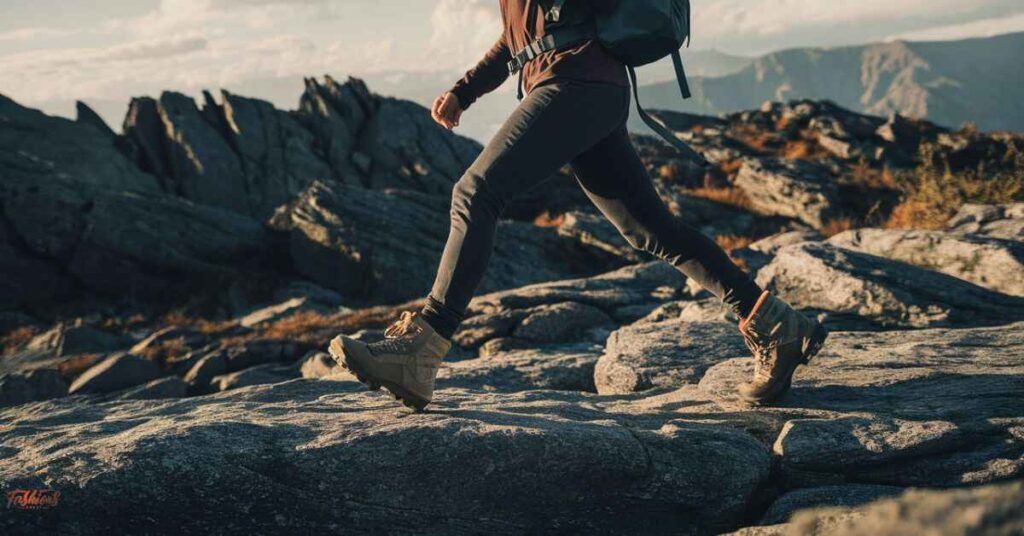
How You Walk?
The way you walk, also known as your gait pattern, can impact the wear pattern on your shoes. Pronation (inward rolling of the foot), supination (outward rolling), or a neutral gait affect how pressure is distributed on the shoes. Overpronation or supination can lead to uneven wear on the shoe’s outsole and affect its stability over time.
Where You Walk?
The surfaces you walk on play a significant role in shoe durability. Rough or abrasive surfaces like concrete, gravel, or rocky terrains can cause faster wear on the outsoles and accelerate the deterioration of shoe materials. Walking on uneven or sharp surfaces can also lead to punctures or tears in the shoe’s upper.
Steps Count
The number of steps you take daily contributes to shoe wear. Regular walkers or individuals with high step counts put more stress on their shoes, leading to faster wear of cushioning materials, outsoles, and upper fabrics. Monitoring your step count can give you an idea of when to consider replacing your shoes.
Hours of Wear
The duration for which you wear your shoes each day affects their lifespan. Extended wear time increases the wear and compression of cushioning materials like midsoles and insoles. Rotating between multiple pairs of shoes can help distribute the wear and allow them to recover between wears, extending their overall lifespan.
Weather
Exposure to different weather conditions can impact shoe longevity. Moisture from rain, snow or sweat can weaken materials, cause mold or mildew growth and lead to unpleasant odors. Extreme temperatures, especially heat, can cause materials like glue to degrade faster.
Properly drying and storing shoes after exposure to moisture or extreme temperatures can help mitigate these effects.
Way to Make Shoes Last Longer?
Taking proactive measures to care for your shoes can significantly extend their lifespan and maintain their quality and comfort over time.
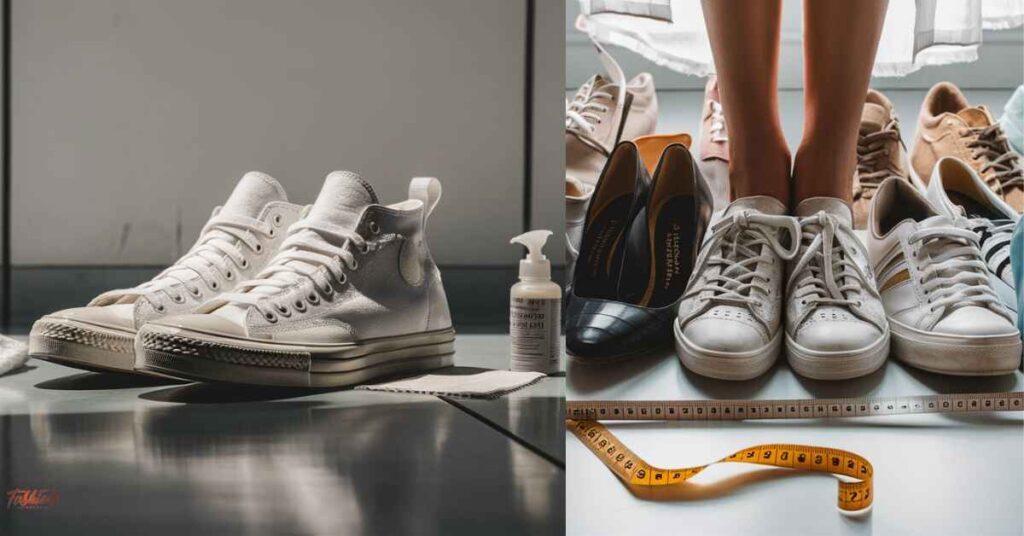
Choose the Right Shoe Size
Ensuring a proper fit is crucial for shoe longevity. Ill-fitting shoes can lead to discomfort, blisters and premature wear. Always measure your foot size accurately and try shoes on before purchasing. Ensure they have adequate toe room and avoid excessively tight or loose fits.
Clean the Shoes Regularly
Regular cleaning helps remove dirt, grime, and stains that can contribute to deterioration. Use appropriate cleaning methods based on the shoe material (e.g., leather cleaner for leather shoes, gentle soap for fabric or synthetic materials). Cleaning also prevents odor buildup and maintains the appearance of your shoes.
Rotate Between Various Shoes at Home
Rotating between multiple pairs of shoes allows them to air out and recover from wear. Avoid wearing the same pair every day, as continuous wear can compress cushioning materials and lead to faster degradation. Alternating between different styles and designs also reduces strain on specific areas of the shoes.
Wear Suitable Shoes for Particular Activities
Using shoes designed for specific activities ensures they can withstand the demands of those activities. For example, wear running shoes for jogging or sports activities, hiking shoes for outdoor adventures and casual shoes for everyday wear. Using the right shoes for the right purpose minimizes wear and tear.
Use Shoe Trees or Stuff with Paper for Storage
Maintaining the shape of your shoes is essential for their longevity. Use shoe trees made of cedar or plastic to help retain the shoe’s form and prevent creases. Alternatively, stuff shoes with acid-free tissue paper or cloth when not in use to maintain their structure and prevent deformation.
Store at a Dry Place
Proper storage is crucial to prevent moisture-related damage. Store shoes in a cool, dry place away from direct sunlight, heat sources or damp areas. Avoid storing shoes in plastic bags or airtight containers, as they can trap moisture and lead to mold or mildew growth. Allow shoes to air out before storing them.
Also Read:
What Does Og All Mean In Shoes?
When to Replace the Shoes?
Knowing when to replace your shoes is essential for maintaining foot health and comfort. Several signs and factors indicate that it’s time to consider getting new footwear.
Check Outsole and Midsole

Inspect the outsole and midsole of your shoes for visible signs of wear and tear. Look for worn-out tread patterns, thinning of midsole cushioning, or cracks in the outsole. If these areas show significant deterioration, it may be time to replace your shoes to maintain proper support and shock absorption.
Check the Upper Side of the Shoes
Examine the upper part of your shoes for signs of damage or wear. Check for creases, scuffs, tears or loose stitching that may compromise the structural integrity of the shoes. Damaged uppers can lead to reduced durability and support, indicating the need for replacement.
Check Inside the Shoes
Inspect the inside of your shoes, particularly the insoles and lining, for signs of wear and compression. Worn-out insoles can cause discomfort and affect cushioning, while deteriorated linings may lead to rubbing or blisters. If the interior shows significant wear, replacing the shoes can improve comfort and prevent foot issues.
Check the Heel Counter
The heel counter, located at the back of the shoe, provides stability and support to the heel. Check for any deformities, cracks or weakening of the heel counter structure. A compromised heel counter can lead to instability, heel pain or discomfort, indicating the need for new shoes with proper heel support.
Workouts Become More Painful
If you experience increased discomfort or pain during workouts or physical activities, it may be a sign that your shoes are no longer providing adequate support or cushioning. Persistent pain in specific areas like arches, heels or ankles could indicate that your shoes have worn out. It may be time for replacement to improve performance and comfort.
Foot Pain
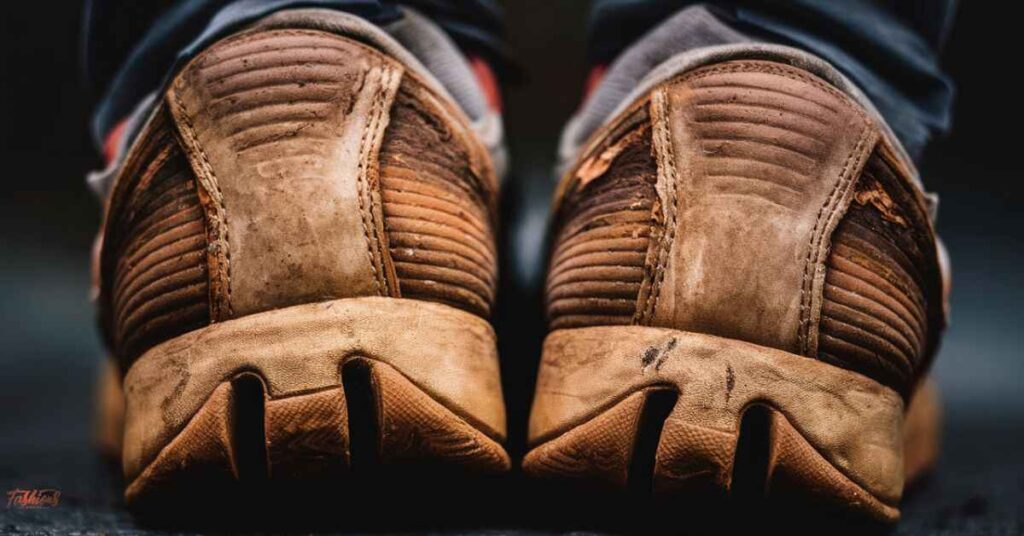
Regular foot pain, especially after wearing your shoes for a prolonged period, suggests that they may no longer offer sufficient support or alignment. Foot pain can result from worn-out cushioning, improper fit, or structural issues in the shoes. Replacing your shoes with ones that address your foot needs can alleviate pain and improve overall comfort.
Loss Of Comfort
If your shoes no longer feel as comfortable as they used to, despite proper care and maintenance, it’s a sign that they have surpassed their effective lifespan. Loss of comfort may be due to worn-out cushioning, decreased support, or changes in the shoe’s structure. Upgrading to new shoes can restore comfort and prevent discomfort or foot-related issues.
Frequently asked questions
How long do shoes last on average?
On average, shoes last between 6 months to 2 years depending on the type of shoe, frequency of use, and maintenance practices. Higher-quality shoes can last longer with proper care and occasional repairs like resoling or reconditioning.
Can shoes last 10 years?
Yes, shoes can last for 10 years or even longer with proper care, occasional repairs, and rotation between multiple pairs to minimize wear. High-quality materials and craftsmanship contribute to the longevity of shoes when well-maintained.
When should you throw away shoes?
Consider throwing away shoes if they show significant wear and tear like worn-out soles or visible damage. Also, replace them if they cause discomfort during wear. Additionally, if your shoes no longer provide adequate support or have lost their original shape, it may be time to replace them for better foot health and comfort.
Why do shoes wear out so fast?
Shoes wear out quickly due to factors like frequent use, harsh walking surfaces, and poor maintenance practices.
How long do Nike shoes last?
Nike shoes typically last between 300 to 500 miles of running or walking, which translates to about 6 months to a year of regular use. However, durability can vary based on usage intensity and maintenance.
Conclusion
Understanding the lifespan of shoes and implementing proactive measures can significantly prolong their durability and comfort. Regularly checking for signs of wear and tear is crucial for extending shoe lifespan. Additionally, choosing the right shoe size, cleaning them regularly, and storing them properly all contribute to their longevity.
Moreover, rotating between multiple pairs and using suitable shoes for specific activities can distribute wear and prevent premature deterioration. Knowing when to replace shoes based on wear patterns, discomfort, or reduced support is crucial for foot health and overall comfort. Incorporate these practices into your shoe care routine to maximize footwear longevity. Enjoy their benefits for years to come as a result.

